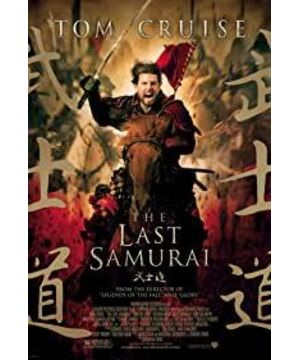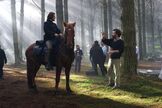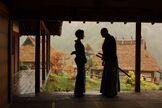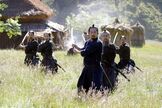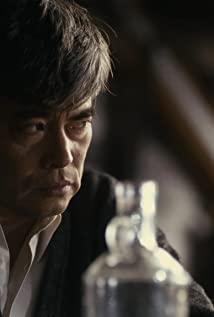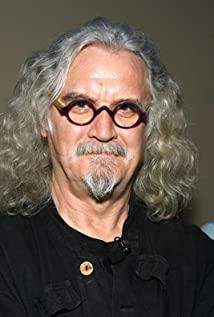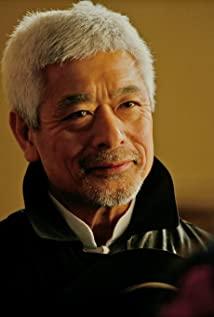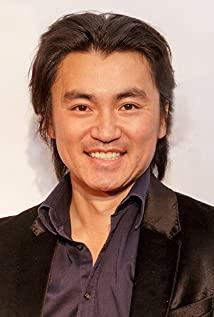There are two types of discrimination, one is "Your race is not good and the other is wrong", and the other is "Your race must live the way I am in my heart". The former is motivated by arrogance, and the latter is motivated by the desire to control. This movie is the latter.
Before starting this topic, please imagine if an Asian made a movie about the American Civil War called "The Last Farmer". The Northern Army, which represents industrial civilization, wears modern military uniforms and holds Springfield 1861 and Cole. Special revolver, pushing the cannon. On the opposite side is the representative of agricultural civilization. The farmer is riding an armored war horse, wearing a Milanese plate armor, holding a three-meter cavalry gun and charging with the slogan of the knight. The reason for the war was because "Southern farmers believed that northern industrial civilization would make people lose their souls and foundations." How would they feel if such ridiculous movies were shown to Americans? In my opinion, the absurdity of this "Last Samurai" is even worse. By the way, the Civil War was only more than ten years earlier than the era of the last warrior.
I watched this movie again after many years, and found that the full nearly three hours was only ignorance and prejudice. Westerners would rather devote their energy to the meticulous service of the magnificent soundtrack and the tasteful scenery, rather than checking some historical materials to rectify the connotation of the film. They can only say that this is not stupid, this is bad. This article is oriented towards popular science. The essential purpose is not to tell how good the samurai is, but to tell everyone that Westerners are bad. They will use this vision to shape Japan, and it is naturally not difficult to imagine the stereotypes of the entire Far East and Southeast Asia in their hearts. If there are any inaccuracies in historical facts, we welcome you to correct them, but my essential purpose is to show the prejudice and arrogance of Westerners by telling historical facts.
1. Japan first came into contact with a matchlock gun from Portugal in 1543. After that, firearms were widely used in the turbulent Warring States period. When Qi Jiguang resisted the Japanese in the Ming Dynasty, there was a record of Japanese pirates using firearms. Out of war needs, Japanese samurai carried out mass production and installation of iron cannons. For example, in the middle of the 17th century, the annual output of iron cannons in Sakai City, a large commercial county in Japan, reached more than 2,000.
But the foreigner thinks that your East Asian civilization should wear armor and fight swords? How can you play with firearms like us?
2. In addition to this large-scale mass production, the Japanese in the 17th century made magical modifications to the iron cannons according to actual battle conditions. The attached picture is a photo taken at the Sakai City Museum in 19 years. The one in the picture is very long and is nearly one meter long. Eight big iron cannons were used to snipe horses, while the shorter iron cannon at the bottom of the other picture was used to shoot horses. The concept is very close to contemporary dragoons.
Not only that, in addition to hardware, multi-angle development has been carried out in aiming, loading, shooting and other technologies. Friends who have played Taige Lizhi Chuan know the skills such as "three-stage strike", "early close", and "bottle-fishing strike".
Among them, Zaohe is a kind of ammunition preservation and filling technology, which first appeared in 1560. It mixes the gunpowder and projectiles in a single shot and puts them in a special bamboo tube to carry around. When shooting, the projectiles and gunpowder are loaded into the barrel at one time. This can increase the filling speed and ensure the uniformity of the charge. Similar paper-tube bullets were made in Europe in the 17th century.
"Three-stage strike" is a shooting tactic, not original in Japan, but it was widely used in the wars of the Warring States Period in Japan. There is a saying that the most elite shooter is placed in the forefront of the team, and the two shooters behind are responsible for loading ammunition and gunpowder. There is also a saying that the team is divided into several columns, each column is ordered to fire in sequence, and the other columns take advantage of this gap to fill with ammunition. To ensure a steady stream of barrage.
The "bottle-fishing strike" is a guerrilla tactic derived from the three-stage strike. The details are a team of four, each responsible for shooting, loading gunpowder, loading projectiles, and adjusting the shooting position. This tactic is generally used in ambushes to harass the enemy in the form of small teams. Its tactical thinking is very close to the hunting tactics of Europe in the 17th and 18th centuries.
I said so much. I just want to say that the Japanese firearms were already playing well in the Warring States Period, and the Warring States Period was 200 years before the "Last Samurai" movie took place.
But Master Yang thought: How could your East Asian national firearms be so slippery? Honestly, fight for the knife!
3. The background of the movie is the Southwestern War and the War Against the Curtain at the time. The actual purpose of this war is here to make it easier for everyone to understand: it is the Japanese government who wants to move the cake of some local emperors in order to establish a modern country. To block people's wealth and kill their parents, the Tui emperor refused to accept it and tore up with the government.
But Master Foreign thinks that you samurai should be the kind of second disease who always cut their belly for ideals and beliefs. How can you fight for such vulgar and realistic reasons? You must fight for your beliefs and ideals!
4. So what was the style of the Satsuma clan of the Choshu clan, who represented the samurai power in the true Southwestern War?
The upper and lower are Changzhou clan soldiers and Satsuma clan soldiers. Except for the older brother with Xiong Ning in the picture, which looks more middle and second, the basic equipment is similar to that of the modern army of the time. During the war, close combat troops may also appear due to insufficient rationing or temporary recruitment. Therefore, the overall picture of the Southwest War and the Falling Curtain War is that two groups of people wearing the new military mansion shoot at each other with guns and cannons. Of course, there will be scenes of drawing swords and each other with Japanese characteristics, but the Southwest War and the Falling Curtain War are basically counted. The above is a modernized war.
The picture below shows the original picture of Mori Katsumoto in the film, the style of Takamori Saigo, the focus is that people wear Western-style military uniforms
But in the eyes of Master Yang, you East Asians should wear armor! It's the feudalism! It is to commit suicide at every turn for the sake of faith! The audience just wanted to watch the machine gun shoot down a Japanese man in a large armor shouting on board! Who wants to see the Japanese in modern military uniforms using modern tactics to shoot at each other!
It doesn't matter how the real Japanese samurai is, but what the Western adults think is important.
So, this is not a Japanese samurai, this is a samurai that foreigners want to see.
One point is given to the service, the road and the scenery, and one point is given to the music. above
tip: In addition, I will give you a little bit of Sakai City
Sakai City is located a dozen or twenty kilometers south of Osaka and can be reached by JR line. If you are interested in cultural aspects, you can play here for a long time before heading to Osaka. Basically, you can walk around for three to four hours. The main attraction is Rikyu Shrine, which commemorates Sen Rikyu and Yosano Akiko, where you can experience tea culture and the modern museum of Sakai. In addition, there is the Sakai City Museum. The exhibits inside are actually more hard-core and in-depth than ordinary museums. There are also famous Mozu Tombs in Sakai City. Japan built a large number of tombs in Sakai during the Kofun period. From the aerial photos, these ancient tombs are actually very spectacular, but the only way to play is to travel around the bus, and such a large-scale tomb from the ground looks like a small mountain bag, so it is a pity.
View more about The Last Samurai reviews


